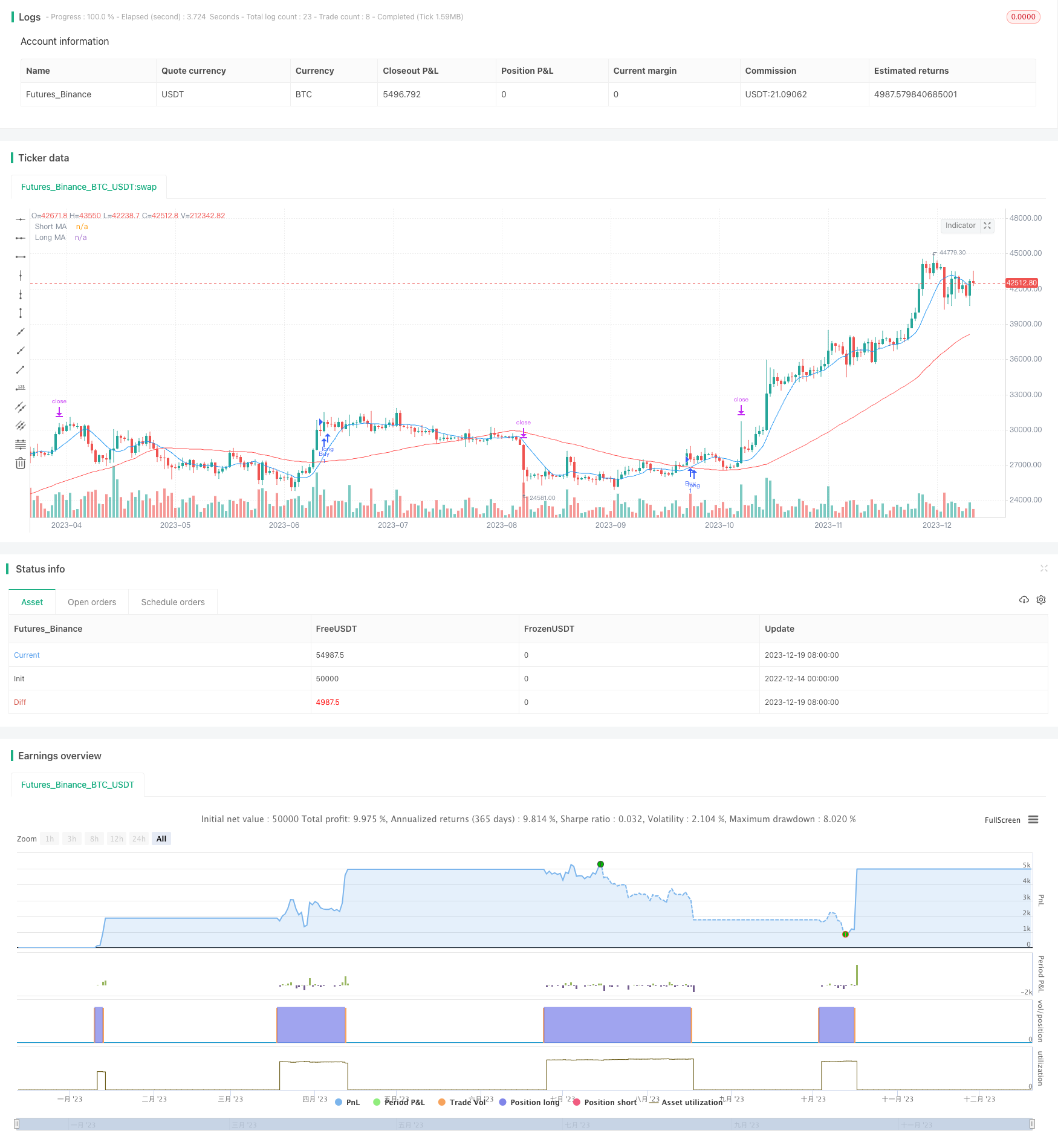Name
基于均线交叉的止损止盈策略Moving-Average-Crossover-Strategy-with-Stop-Loss-and-Take-Profit
Author
ChaoZhang
Strategy Description
该策略通过计算不同周期的移动平均线,设定止损止盈点,实现自动交易。当短周期移动平均线上穿长周期移动平均线时做多;当短周期移动平均线下穿长周期移动平均线时做空。同时设置止损和止盈点来控制风险。
该策略基于均线交叉原理。它同时计算9日简单移动平均线和55日简单移动平均线。当9日均线上穿55日均线时,代表短期趋势反转为上涨,此时做多;当9日均线下穿55日均线时,代表短期趋势反转为下跌,此时做空。
同时,该策略利用ATR指标设置止损和止盈点。ATR指标可以衡量市场波动幅度。止损点设置为收盘价减去ATR值,这样可以根据市场波动性来設置合理的止损;止盈点利用风险回报比例来设定,这里设置为风险回报比例为2,即止盈 = 收盘价 + 2 * ATR值。
这是一个非常简单实用的短线交易策略,有以下几个优势:
- 均线交叉原理简单易懂,容易掌握;
- 同时结合止损和止盈,可以有效控制风险,增强实用性;
- 移动平均线参数可以灵活调整,适应不同市场环境;
- ATR止损可以根据市场波动性设定止损点,比较智能;
- 风险回报比例设置可以根据个人风险偏好调整。
该策略也存在一些风险:
- 均线交叉信号可能出现假突破,引发错误交易;
- 止损或止盈设置不当可能增大亏损或减小盈利;
- 移动平均线参数设置不当会导致交易频率过高或信号滞后;
- ATR参数设置不当也会使止损点过近或过远。
对于这些风险,可以通过优化参数、严格止损、合理位置管理来降低。
该策略还可以进一步优化:
- 利用优化工具寻找最佳移动平均参数组合;
- 增加其他指标过滤均线交叉信号,避免假突破;
- 尝试其他类型的移动平均线,如指数移动平均线等;
- 可以考虑将ATR参数也加入优化,使止损止盈更加智能。
该策略整体思路清晰、易于实现,特别适合初学者掌握。作为一个基础的短线交易策略,它具有操作简单、容易优化等优点。如果搭配COMPLETE或其他框架使用,可以进一步强化该策略,使之成为一个足够实用的量化交易系统。
||
This strategy calculates moving averages of different periods, sets stop-loss and take-profit points to implement automated trading. It goes long when the short period moving average crosses above the long period moving average, and goes short when the short period moving average crosses below the long period moving average. Meanwhile, it sets stop-loss and take-profit points to control risks.
This strategy is based on the moving average crossover principle. It calculates both 9-day and 55-day simple moving averages simultaneously. When the 9-day MA crosses above the 55-day MA, it signals that the short-term trend has reversed to upside, so goes long. When the 9-day MA crosses below the 55-day MA, it signals that the short-term trend has reversed to downside, so goes short.
In the meantime, this strategy utilizes the ATR indicator to set stop-loss and take-profit points. The ATR indicator can measure the degree of price volatility in the market. The stop-loss point is set at the close price minus the ATR value, so it can set a reasonable stop-loss based on market volatility. The take-profit point uses a risk-reward ratio, which is set at 2 here - take profit = close price + 2 * ATR value.
This is a very simple and practical short-term trading strategy with the following advantages:
- The moving average crossover principle is easy to understand and master;
- The combination of stop-loss and take-profit effectively controls risks and enhances practicality;
- The moving average parameters can be flexibly adjusted to adapt to different market environments;
- The ATR stop-loss can set stop-loss points based on market volatility, quite intelligent;
- The risk-reward ratio setting can be adjusted according to personal risk preference.
There are also some risks with this strategy:
- Moving average crossover signals may have false breakouts, causing wrong trades;
- Improper stop-loss or take-profit settings may increase losses or reduce profits;
- Improper moving average parameters may lead to too high trading frequency or lagging signals;
- Improper ATR parameter settings may also make stop-loss points too close or too far.
These risks can be reduced by optimizing parameters, strict stop-loss, and reasonable position sizing.
This strategy can be further optimized:
- Use optimization tools to find the optimal moving average parameter combination;
- Add other indicators to filter the moving average crossover signals to avoid false breakouts;
- Try other types of moving averages, such as exponential moving averages, etc.;
- Consider adding the ATR parameter to optimization as well to make the stop-loss and take-profit more intelligent.
The overall logic of this strategy is clear and easy to implement, especially suitable for beginners to master. As a basic short-term trading strategy, it has the advantages of simple operation and easy optimization. When combined with COMPLETE or other frameworks, it can be further enhanced to become a practical quantitative trading system.
[/trans]
Strategy Arguments
| Argument | Default | Description |
|---|---|---|
| v_input_1 | 9 | Short MA Length |
| v_input_2 | 55 | Long MA Length |
| v_input_3 | 2 | Risk-Reward Ratio |
Source (PineScript)
/*backtest
start: 2022-12-14 00:00:00
end: 2023-12-20 00:00:00
period: 1d
basePeriod: 1h
exchanges: [{"eid":"Futures_Binance","currency":"BTC_USDT"}]
*/
//@version=5
strategy("MA Crossover Strategy with Stop-Loss and Take-Profit", overlay=true)
// Input for selecting the length of the moving averages
maShortLength = input(9, title="Short MA Length")
maLongLength = input(55, title="Long MA Length")
// Input for setting the risk-reward ratio
riskRewardRatio = input(2, title="Risk-Reward Ratio")
// Calculate moving averages
maShort = ta.sma(close, maShortLength)
maLong = ta.sma(close, maLongLength)
// Buy condition: 9-period MA crosses above 55-period MA
buyCondition = ta.crossover(maShort, maLong)
// Sell condition: 9-period MA crosses below 55-period MA
sellCondition = ta.crossunder(maShort, maLong)
// Set stop-loss and take-profit levels
atrValue = ta.atr(14)
stopLossLevel = close - atrValue // Use ATR for stop-loss (adjust as needed)
takeProfitLevel = close + riskRewardRatio * atrValue // Risk-reward ratio of 1:2
// Execute buy and sell orders with stop-loss and take-profit
strategy.entry("Buy", strategy.long, when = buyCondition)
strategy.exit("Sell", from_entry="Buy", loss=stopLossLevel, profit=takeProfitLevel)
// Plot moving averages on the chart
plot(maShort, color=color.blue, title="Short MA")
plot(maLong, color=color.red, title="Long MA")
Detail
https://www.fmz.com/strategy/436140
Last Modified
2023-12-21 15:52:57
